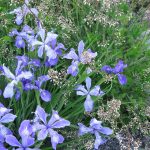August went by in flash, as usual. Daily watering chores. Jam making. An ocean of applesauce. After a week’s vacation in a cabin by the Metolius, I somehow carved out time to think about the fall and winter vegetable garden. Space must be carved out, too, and I’m grateful for any crops that can go in after the pole beans and tomatoes are torn out in October. But starts of red Russian kale, my favorite for winter eating, need to go in as soon as possible. By October what you see is more or less what you get until growth starts up again in March. Continue reading →


